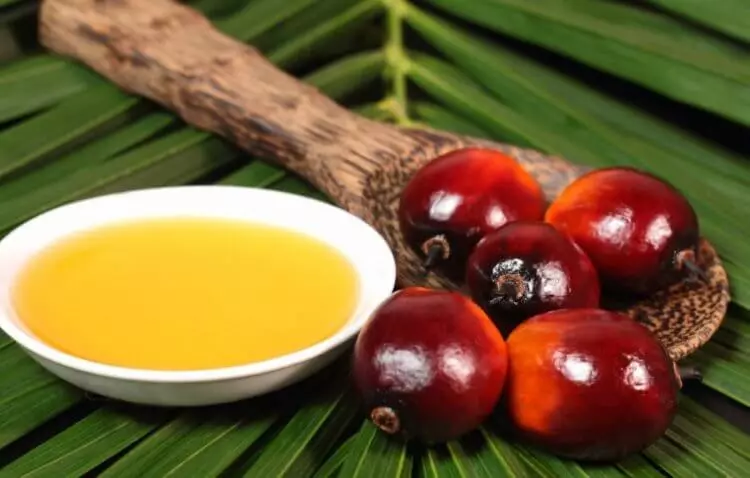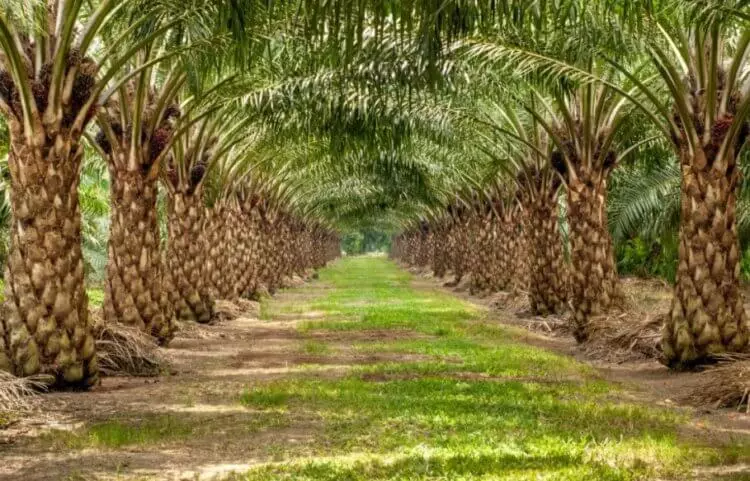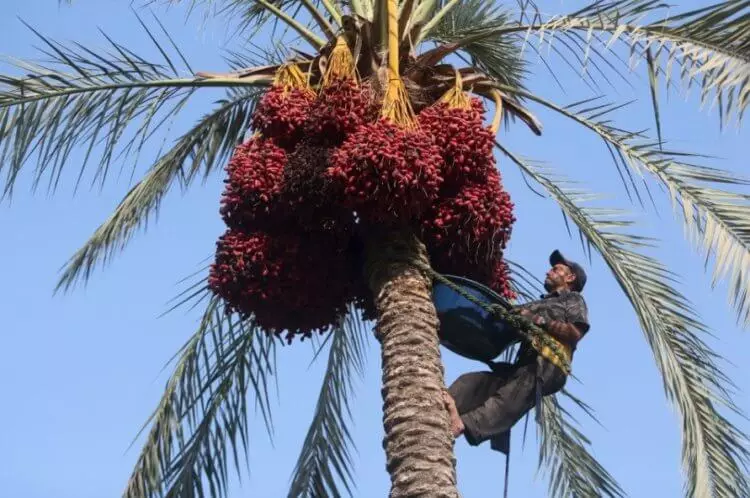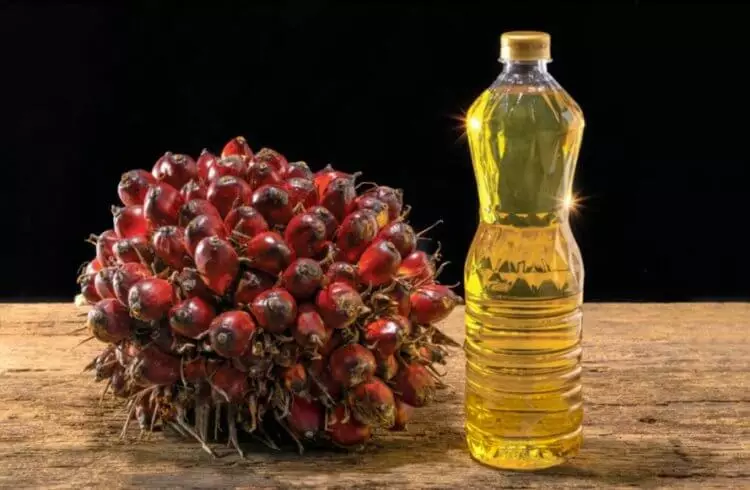As part of many foods, you could notice the palm oil content. This component is removed from the fruits of oil palm (Elaeis Guineensis), which grows on Africa, Latin America and Asia plantations. In Russia, palm oil appeared only in the 1960s and since then it is often used as a substitute for milk fat, as well as in the production of bakery products. It is also a component of biofuels and is part of some shampoos and cosmetics. In general, palm oil is an important component of many products and you can tell a lot of interesting things about it. As part of this article, I propose to find out when people thought of extracting oil from the fruits of oilseed palm and how it is produced in modern times. Well, of course, we learn about the benefits and harmfulness of palm oil, because this question is clearly interested in very many people.

History of palm oil
The first mention of palm oil dates back to the XV century - records were made by Portuguese travelers who visited West Africa. It is this place that is home to oil palm trees, of which local residents still remove palm oil with traditional methods. The resulting product is consumed in raw form, as an important ingredient of national dishes. Thousands of years ago, Palm oil began to be supplied in ancient Egypt, and in 1870 it arrived in Malaysia. In the 1960s, thanks to suppliers from Indonesia, the oil appeared in Russia. Oil palm trees were loved by everyone, because they are very hardy and give a large harvest, from which you can get excellent vegetable oil.

Maturation of oilseeds
Most of the entire plantations of oil palm are located in Africa, Latin America and Asia. Trees reach maturity at 3 years and give fruit for 35 years. So that the seeds of the seeds ripen faster, they are planting them in greenhouses - it allows you to reduce the time of germ until 100 days. Saplings remain in containers about 5 months until the leaves appear on them. After that, they move to the nursery, where they remain throughout the year, before approaching about 15 leaves. After that, the seedlings are planted into the open ground.

Oil palm trees are very demanding to the surrounding conditions of the trees. They love warmth and require a lot of water, so the soil must miss moisture well. On plantations often appear rodents that spoil trees. To get rid of them, the territory will be allowed owls that actively catch pests and protect plantations. The advantage of this method of protecting trees is that it does not harm the environment. The use of chemicals could create more problems than solved.
It is important to note that forests are often cut down for the construction of plantations of oilseeds. This is a big problem, because thereby people deprive the animals of the natural habitat, which leads to their extinction.
Palm oil production
Thanks to modern equipment, the production of palm oil occurs almost brought to automatism. Production technology can be divided into 8 stages:- Getting fresh fruits, which within 24 hours after collection are sent to the plant for further processing;
- Sterilization, during which the fruits are cleaned of garbage and insects. For sterilization, superheated steam is usually used, which, in addition, facilitates the release of oil from fruits;
- Mold, in which only ripe fruits are allocated from the collected heap;
- Digestion, in the process of which the fruits are thermal processing. This is necessary so that oil is faster and easier to be released from plant cells;
- pressing in which the fruits turn out to be under high pressure and release oil;
- Flushing, within which the oil is mixed with clean water and is released from water-soluble impurities. After that, the mixture is sent to the centrifugal separator, where the water is separated from the oil. As a result, raw palm oil is obtained, which can already be considered an independent product;
- But there is still a stage of refining, that is, cleaning from unnecessary impurities. For this, superheated pairs are used, after which the oil is bleached and is thermally processed in vacuum conditions;
- Fractions - often the last stage of palm oil treatment. During this process, the oil acquires a liquid or solid shape.
As can be seen, the production of palm oil is a complex, but automated process. After all these stages, it can be used in the manufacture of food. In its pure form, palm oil has a red-orange color, and the smell and taste is the same as the fruit of oil palm.
Read also: What worms can be officially eaten?
Palm oil composition
Palm oil is 100% fat. The main fats are palmitic, oleic, linoleic and stearic acids. In one tablespoon of real palm oil contains:
- 114 calories;
- 14 grams of fat;
- 11% of the daily rate of vitamin E, which is needed to protect cells, proteins and DNA.
Palm oil in large quantities is contained in sweets, cream, margarine, cookies, canned food and baby food. According to WWF for 2020, palm oil is actively buying companies such as PepsiCo, Nestle, McDonalds and Colgate-Palmolive. This means that it is also a component of carbonated drinks, fast food and personal hygiene. The big popularity of palm oil is associated with its relative cheap.

In the course of scientific research, scientists were able to prove that palm oil can bring to human body much benefit. The substances contained in it have a positive effect on the health of the brain. Once scientists gathered a group of 120 people and divided them into two groups. The first received placebo, and the second is the components of palm oil. Subsequently, it turned out that people from the second group were less likely observed brain damage. Based on this, scientists concluded that palm oil protects against age-degraded memory.

But in the course of some studies, scientists came to the conclusion that palm oil is still dangerous for the human body. Once they noticed that its use leads to an increase in cholesterol, which can lead to cardiovascular diseases. Especially harmful is the re-heated palm oil, because it is the cause of deposits inside the arteries.
If you are interested in science and technology news, subscribe to our channel in Yandex.Dzen. There you will find materials that were not published on the site!
In general, if you say short, palm oil is well affected on the brain and bad on the heart. But it is not necessary to conclude that palm oil is bad. When heated above 200 degrees, any fat becomes harmful. When using any product, it is important to observe the measure and then nothing bad happens. At the moment, the World Health Organization does not attribute palm oil to dangerous products. Even on the contrary - experts report that it is the richest vegetable source of vitamin A.. This fact should pay attention to the vegans that I wrote about this material.
